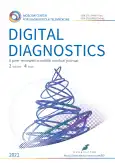The increasing role of functional visualization modalities for navigation of external beam radiation therapy and brachytherapy in prostate cancer
- Authors: Rumyantsev P.O.1
-
Affiliations:
- SOGAZ International Medical Center
- Issue: Vol 2, No 4 (2021)
- Pages: 488-497
- Section: Editorials
- URL: https://journals.rcsi.science/DD/article/view/96197
- DOI: https://doi.org/10.17816/DD96197
- ID: 96197
Cite item
Abstract
Brachytherapy is successfully used in the treatment of malignant neoplasms in males and females and rare cases in children, as an independent method (with localized prostate cancer) or adjuvant with remote focal radiation therapy (with cancer of the cervix, anal canal, head and neck, breast, etc.).
The expansion of diagnostic capabilities (the advent of computer and magnetic resonance imaging) due to three-dimensional imaging has given brachytherapy an important technological advantage over other methods. Many options are available for combining brachytherapy with remote radiation or systemic antitumor therapy in the first line, as well as in a single mode for localized tumor recurrence in a previously irradiated area.
Intrastates (hollow tubes) for intra-tissue high-dose brachytherapy are administered during surgery and encapsulated (closed) radioactive micro-sources for low-dose brachytherapy are directly administered (percutaneously).
A distinctive feature of brachytherapy is a sharp drop in the dose outside the tumor focus, which minimizes the risk of irradiation of surrounding organs and tissues.
The main advantage of brachytherapy in comparison with remote radiotherapy is a higher radiation dose gradient at the tumor border (from all sides). Moreover, clarifying the boundaries of uncertainty when irradiating the target is unnecessary. When the tumor changes during treatment, the sources fixed in the tumor synchronously change their position.
In addition to the advantages in efficiency and safety, the total financial costs of brachytherapy are significantly lower than other radiotherapy options.
Full Text
##article.viewOnOriginalSite##About the authors
Pavel O. Rumyantsev
SOGAZ International Medical Center
Author for correspondence.
Email: pavelrum@gmail.com
ORCID iD: 0000-0002-7721-634X
SPIN-code: 7085-7976
Scopus Author ID: 12800559900
ResearcherId: C-6647-2012
MD, Dr. Sci. (Med.)
Russian Federation, 8 Malaya Konyushennaya str., Saint Petersburg, 191186References
- Vu CC, Jawad MS, Krauss DJ. The cost-effectiveness and value proposition of brachytherapy. Semin Radiat Oncol. 2020;30(1):87–93. doi: 10.1016/j.semradonc.2019.08.007
- Chin J, Rumble RB, Kollmeier M, et al. et al. Brachytherapy for patients with prostate cancer: American Society of Clinical Oncology / Cancer Care Ontario joint guideline update. J Clin Oncol. 2017;35(15):1737–1745. doi: 10.1200/JCO.2016.72.0466
- Kee DL, Gal J, Falk AT, et al. Brachytherapy versus external beam radiotherapy boost for prostate cancer: systematic review with meta-analysis of randomized trials. Canc Treat Rev. 2018;70:265–271. doi: 10.1016/j.ctrv.2018.10.004
- Kishan AU, Cook RR, Ciezki JP, et al. Radical prostatectomy, external beam radiotherapy, or external beam radiotherapy with brachytherapy boost and disease progression and mortality in patients with Gleason score 9–10 prostate cancer. JAMA. 2018;319(9):896–905. doi: 10.1001/jama.2018.0587
- Abecassis JP, Ghazzar N, Peyromaure M, Giraud P. Prostate imaging: contribution of PET PSMA and MRI. Cancer Radiother. 2020;24(5):423–428. doi: 10.1016/j.canrad.2020.06.002
- Delgadillo R, Ford JC, Abramowitz MC, et al. The role of radiomics in prostate cancer radiotherapy. Strahlenther Onkol. 2020;196(10):900–912. doi: 10.1007/s00066-020-01679-9
- Cysouw MC, Jansen BH, van de Brug T, et al. Machine learning-based analysis of [18F]DCFPyL PET radiomics for risk stratification in primary prostate cancer. Eur J Nucl Med Mol Imaging. 2021;48(2):340–349. doi: 10.1007/s00259-020-04971-z
- Eiber M, Weirich G, Holzapfel K, et al. et al. Simultaneous 68Ga-PSMA HBED-CC PET/MRI Improves the Localization of Primary Prostate Cancer. Eur Urol. 2016;70(5):829–836. doi: 10.1016/j.eururo.2015.12.053
- Donato P, Roberts MJ, Morton A, et al. Improved specificity with 68Ga PSMA PET/CT to detect clinically significant lesions “invisible” on multiparametric MRI of the prostate: a single institution comparative analysis with radical prostatectomy histology. Eur J Nucl Med Mol Imaging. 2019;46(1):20–30. doi: 10.1007/s00259-018-4160-7
- Rylander S, Polders D, Steggerda MJ, et al. Re-distribution of brachytherapy dose using a differential dose prescription adapted to risk of local failure in low-risk prostate cancer patients. Radiother Oncol. 2015;115(3):308–313. doi: 10.1016/j.radonc.2015.05.015
- Hsu CC, Hsu H, Pickett B, et al. Feasibility of MR imaging/ MR spectroscopy-planned focal partial salvage permanent prostate implant (PPI) for localized recurrence after initial PPI for prostate cancer. Int J Rad Oncol Biol Phys. 2013;85(2):370–377. doi: 10.1016/j.ijrobp.2012.04.028
- Thorwarth D, Beyer T, Boellaard R, et al. Integration der FDG-PET/CT-Bildgebung in die Planung der externen Strahlentherapie ― Technische Aspekte und Empfehlungen zur methodischen Annäherung. Nuklear Med. 2012;51(4):140–153. doi: 10.3413/NUKMED-0455-11-12
- Tait LM, Hoffman D, Benedict S, et al. The use of MRI deformable image registration for CT-based brachytherapy in locally advanced cervical cancer. Brachytherapy. 2016;15(3):333–340. doi: 10.1016/j.brachy.2016.01.002
- Blanchard P, Ménard C, Frank SJ. Clinical use of magnetic resonance imaging across the prostate brachytherapy workflow. Brachytherapy. 2017;16(4):734–742. doi: 10.1016/j.brachy.2016.11.012
- Schernberg A, Kumar T, Achkar S, et al. Incorporating Magnetic Resonance Imaging (MRI) based radiation therapy response prediction into clinical practice for locally advanced cervical cancer patients. Sem Radiat Oncol. 2020;30(4):291–299. doi: 10.1016/j.semradonc.2020.05.007
- Park H, Meyer CR, Wood D, et al. Validation of automatic target volume definition as demonstrated for 11C-Choline PET/CT of human prostate cancer using multi-modality fusion techniques. Acad Radiol. 2010;17(5):614–623. doi: 10.1016/j.acra.2010.01.003
- Fassbender TF, Schiller F, Zamboglou C, et al. Voxel-based comparison of [68Ga]Ga-RM2-PET/CT and [68Ga]Ga-PSMA-11-PET/ CT with histopathology for diagnosis of primary prostate cancer. EJNMMI Res. 2020;10(1):62. doi: 10.1186/s13550-020-00652-y
- Aerts HJ, Bussink J, Oyen WJ, et al. Identification of residual metabolic-active areas within NSCLC tumours using a pre-radiotherapy FDG-PET-CT scan: a prospective validation. Lung Cancer. 2012;75(1):73–76. doi: 10.1016/j.lungcan.2011.06.003
- Lucia F, Miranda O, Abgral R, et al. Use of baseline 18F-FDG PET/ CT to identify initial sub-volumes associated with local failure after concomitant chemoradiotherapy in locally advanced cervical cancer. Front Oncol. 2020;10:678. doi: 10.3389/fonc.2020.00678
- Gardin I. Methods to delineate tumour for radiotherapy by fluorodeoxyglucose positron emission tomography. Canc Radiother. 2020;24(5):418–422. doi: 10.1016/j.canrad.2020.04.008
- Brown AP, Pugh TJ, Swanson DA, et al. Improving prostate brachytherapy quality assurance with MRI-CT fusion-based sector analysis in a phase II prospective trial of men with intermediate-risk prostate cancer. Brachytherapy. 2013;12(5):401–407. doi: 10.1016/j.brachy.2012.10.001
Supplementary files









